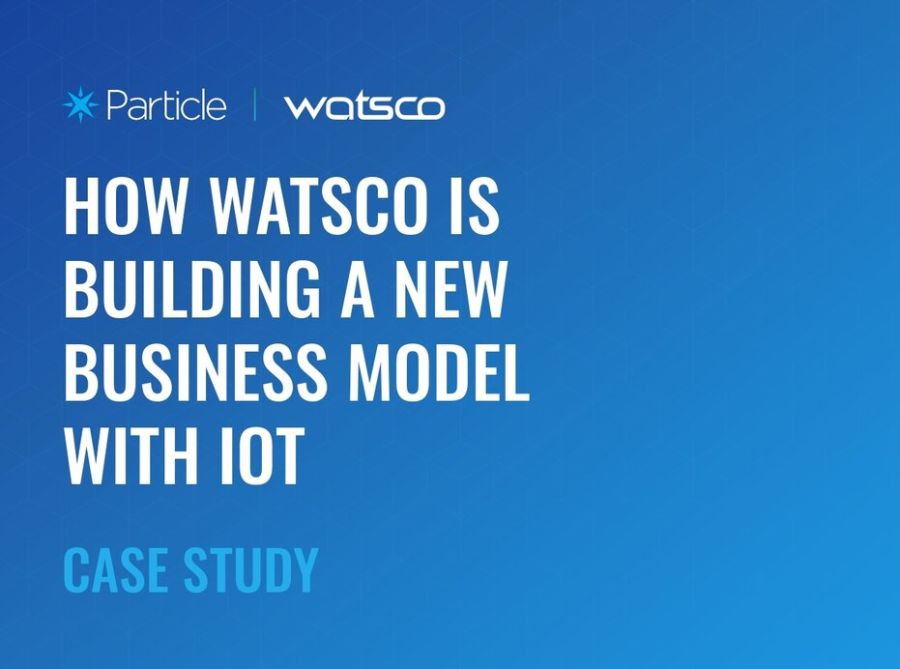A Framework for Creating an IoT Go-to-Market Strategy
Launching a connected product without a clear go-to-market strategy is one of the surest ways to fail in a hardware/software business. Learn this framework for thinking critically about how to deliver value to your market with connectivity.
Ready to build your IoT product?
Create your Particle account and get access to:
- Discounted IoT devices
- Device management console
- Developer guides and resources
Say "connected devices" and somebody's bound to think of a WiFi–enabled toaster or a smart fridge, but the Internet of Things isn’t really about using smart technology to get the perfect piece of toast. Sorry, would-be breakfast industry disruptors.
Instead, IoT is about creating additional value—for the buyer, for the seller, and sometimes for those who come in between.
But first you need to know how—and why—to go to market.
Why You Need a GTM Strategy for Connected Products
Let’s answer this question with another question: Remember the "smart toaster" from the opening of this article? That’s what happens when you launch an Internet-connected product without a GTM strategy.
Long story short, defining your GTM strategy for IoT is about identifying where the value of your connected products will lie in the value chain.
Is it with the consumer? With the manufacturer? With the distributor? With a third party?
Spoiler alert: There’s a good chance it's with the manufacturer or distributor (B2B, in other words). McKinsey estimates that B2B applications will account for 65% of the value derived from all IoT deployment by 2030. In particular, production and manufacturing environments stand to gain as IoT solutions look to reduce risks and optimize processes.
Right now, quick-moving companies see a major opportunity to deliver IoT solutions for other businesses—but adding IoT capabilities just because you can is the fastest way to compound or needlessly pass along unrecouped business expenses to end-users.
To identify how and where you're creating value, along with where to capture that value in the chain, you'll need an IoT GTM strategy.
Consider this your 101-level guide.
First, we'll take a look at the business case for IoT before exploring the principal ways value is captured in an IoT solution. Finally, we'll identify the most important thing your IoT GTM strategy needs to be successful.
Determining the Business Case for IoT
Before building an IoT product and investing in infrastructure, you need to determine your business case. Too often, organizations start with an "intent to connect" and focus on the technical challenges of IoT instead of considering how the technology will augment their business model—and likely change it over time.
IoT is ultimately a technical solution to a business problem. With this in mind, making a business case for an IoT investment means determining whether the savings or profit delivered by the solution are greater than the annual cost of implementation.
At this stage, companies often misdiagnose the business problems they're facing, which results in them building an IoT product that doesn't deliver real value.
We talk to a lot of company leaders who feel they need to "IoT-ize" their products to make them "modern." But whether you're selling to consumers or business decision-makers, it's important to first determine if your audience actually cares about whatever product capabilities are enabled by connectivity. In other words, the right place to start is with the buyer.
More specifically, you'll need to study your eventual decision-maker and validate the use case before you decide to invest in IoT just for the sake of it. After all, IoT products only prove economically viable when they deliver continuous, recurring value for your business and your customers.
So, how can you make your revenue stream more predictable and stable? How can you build longer-term relationships with your customers? An IoT strategy can certainly solve specific problems, but it can also be a tool to transform your business value for the better.
Finding Value in IoT
We’ve found that there are two primary ways in which IoT creates business value: through optimization and through growth.
Optimization…
…via cost savings
Equipment and other company assets being out of commission cuts into production and impacts the bottom line. Preventive maintenance helps address this issue—in fact, McKinsey found that digitizing maintenance programs can save companies up to 25% on maintenance costs.
However, traditional preventative maintenance is based on frequency. Imagine a driver who changes their oil every three months or 5,000 miles, regardless of whether they actually need to. Knowing the precise moment that they need to change their oil would be more beneficial, and delivering this type of information is one of the promises of IoT (cost optimization driven by IoT-enabled maintenance and servicing to yield the highest possible returns).
Consider a production company that uses generators and other heavy machinery. Using IoT-enabled, condition-based preventive maintenance, the company could cancel out the cost inefficiencies inherent in time- or schedule-based checkups that don't take the generator's condition into account.
As another example, smart grid-enabled technologies could remotely monitor the performance of a remote energy source—solar farms, for instance—to ensure the highest possible energy yield.
…via risk reduction
IoT doesn’t only optimize maintenance—it can also reduce risk.
Although risk is baked into certain products, IoT can serve as an effective risk mitigation tool. For example, an IoT sensor connected to a boiler might prevent a building from catching on fire, while an e-bike with IoT capabilities is better protected against theft.
Beyond the inherent risk associated with some products, regulatory risk is part of the price of doing business for companies in certain industries; for instance, companies that produce carbon emissions face regulatory scrutiny in the form of emissions monitoring. With the correct IoT-enabled emissions monitoring solution, such companies can streamline their compliance efforts while reducing regulatory risk.
Growth…
…via additional revenue streams
IoT solutions can help you tailor your offerings and improve customer experience based on your customers' actual usage patterns and behaviors.
In the light electric vehicle industry, for example, manufacturers can use sensors to gain insight into how customers are using their vehicles. When it's time to go into feature development mode, these manufacturers know what their customers find valuable and can identify new, better opportunities to upsell, cross-sell, and sell at better margins based on insights gleaned from IoT-powered data.
…via increasing LTV
Long story short: You can increase your customer lifetime value by using IoT.
Connected products facilitate recurring revenue streams for businesses that used to be based on offering one-off services—for example, pay-as-you-go air conditioning and e-vehicles that depend on connectivity to track trip data and charge users based on distance traveled are built around IoT.
In product-as-a-service-based business models such as aircraft engines sold and priced based on flight time, generating a steady revenue stream is tied tightly to customer growth. In this case, customer LTV is improved thanks to the value of the data generated by the IoT-connected engine.
Lastly, consider a hot tub. While its job is to heat water, the value proposition for a customer is based on the relaxing experience of using it. With this in mind, a connected hot tub can decrease the burden of maintenance for the end-user, leading to less time spent on upkeep and more time to relax.
Beyond these use cases, connectivity is broadly good for business. After all, value-additive services and historical data gathered from connected products increase the cost of switching for consumers, creating loyalty to—and a preference for—the initial provider.
In these ways, IoT uses connectivity to make customer LTV easier to forecast and increase, while also reducing the burden of ownership for the consumer.
Creating a B2B IoT GTM Strategy
A GTM strategy for B2B IoT requires buy-in from more than your product development, IT, and engineering teams—sales, marketing, and business operations also need to be involved in delivering an IoT product.
Without a well-thought-out GTM strategy, you run the risk of selling shiny connected widgets that no one really needs… or wants. Don't assume that buyers will pay for enhanced IoT capabilities based on novelty alone, in either a B2B or a B2C context. Ultimately, the best IoT products solve real-world problems that at least one participant in the value chain is willing to pay for, be it the manufacturer, the distributor, or the end-user.
Consider Watsco, an HVAC distributor that largely sells to contractors fulfilling installations in both residential and commercial settings.
When Watsco rolled out connected systems, the business value quickly became clear to contractors: Not only could they now sell HVAC systems, they could also capture an additional revenue source by offering monthly data-driven maintenance services powered by these connected systems. In this case, IoT deployment was a win for distributors, contractors, and end-users.
Solidify your IoT GTM strategy by figuring out where value is actually being captured in the value chain, then working backward.
These four questions will help get you there:
- What potential capabilities could be delivered via a connected device?
- Who is willing to pay more for a connected device and why?
- Where and how do we capture the value in the value chain?
- How can delivering on this strategy create a step change in the value of my business (e.g., by delivering a hardware-as-a-service experience)?
Traditional GTM vs. IoT GTM: Two Distinct Differences
In many ways, a GTM strategy for a B2B IoT solution is similar to a GTM strategy for other products, as figuring out product-market fit is equally as important for connected and non-connected products.
However, there are two important considerations to keep in mind for IoT-enabled products: distribution partners and feedback loops.
When selling IoT products, figuring out how to make demand generation work can lead to channel conflicts when the nature of IoT disrupts the relationship between manufacturer and consumer. Simply put, the manufacturer-consumer relationship becomes more direct than it would be if a dealer were to serve as the intermediary. Tesla is an example of a company that addresses the question of channel disruption by bringing its product directly to consumers instead of establishing franchised dealerships.
With regard to feedback loops, bringing connectivity to a hardware product can fundamentally change GTM and product development strategies, which is why change management is so critical for any IoT project. Although hardware problems are generally much more difficult to correct than software bugs, the data supplied by connected hardware products can yield unprecedented insights into consumer use and preferences. Building upon the creation of new feedback loops, companies can use IoT to construct improved, agile product development processes.
Particle + Watsco
Case Study
Learn how Watsco, the largest distributor of air conditioning, heating, and refrigeration units, redefined its business model with connectivity.

Getting to a Proof of Concept and Validating Your GTM Strategy
Once you have your GTM strategy in mind, how can you go from an initial idea to a working PoC?
Companies can use IoT development tools to build a prototype faster, efficiently verifying whether an idea is worth scaling up with a real-world PoC.
This is a big shift—not so long ago, implementing IoT required either solutions built in-house that had to make edge, connectivity, and software capabilities "talk to each other" or complex platforms that required IoT-specific expertise to use. Even in initial phases, the IoT projects of the distant past were costly, complex, and risky.
Now, IoT Platform-as-a-Service solutions like Particle combine agile hardware development, easy-to-use development environments, connectivity that works out of the box, and industry-leading over-the-air software update capabilities to make testing, implementing, and improving IoT solutions easier than ever. That's why more than 90% of our customers ship a market-ready product in six to 12 months.
Overall, having a subscription-based IoT solution means companies can act on feedback from connected products much faster than traditional SKUs, bringing an agile element to a typically slower waterfall process.
Once you know where—and how—your IoT-enabled products will benefit the value chain, making technical and product decisions becomes less daunting.
The Authors
![Zach Supalla]()
Zach Supalla
CEO and co-founder, Particle
![dan headshot]()
Dan Jamieson
COO, Particle

